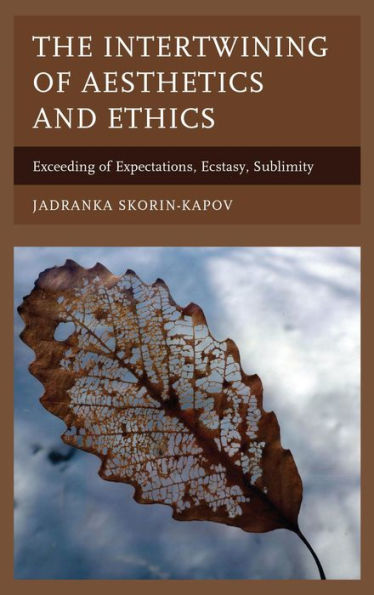The Intertwining of Aesthetics and Ethics: Exceeding of Expectations, Ecstasy, Sublimity analyzes the common experiential ground for both aesthetics and ethics by considering experiential environment (both nature and art), the precedents to desire, the notion of experience incorporating a break, and the reverberations of surprise leading to the intertwining of aesthetics and ethics. Jadranka Skorin-Kapov discusses different philosophical positions on the relationship between nature and art, in conversation with Kant, Hegel, Goethe, Gadamer, and Adorno. She argues that Kantian sublimity can carry over from nature to art. As part of the discussions of expectations and authenticity, the author interprets Husserl’s view on expectations, Heidegger’s view on death and authenticity, Blanchot’s view on death, and Arendt’s view on natality. As for understanding the aesthetic experience as the paradigmatic experience, Skorin-Kapov is informed by Dewey’s work on art as experience, Gadamer’s work on experience of art, and Jauss’s work on the aesthetics of reception and the horizon of expectations. After our sensibility and representational capability are broken, recuperation then leads to sublimity and the subsequent feelings of admiration and/or responsibility, allowing for the intertwining of aesthetics and ethics. Additionally, elements of Kantian morality, Foucault’s ethics, and Kierkegaard’s work on interactions between aesthetics and ethics together help to characterize the relation between aesthetics and ethics. Since we often encounter surprise due to unexpectedness in comedy, Skorin-Kapov also interprets philosophical views on the comedy and laughter (including Aristotle, Kierkegaard, Meredith, and Bergson), using the theatrical work of Dario Fo as an example.
The novel analysis in The Intertwining of Aesthetics and Ethics will be of particular interest to students and scholars working or teaching in aesthetics, phenomenology, art history, cultural studies, and ethics.
"1123514687"
The novel analysis in The Intertwining of Aesthetics and Ethics will be of particular interest to students and scholars working or teaching in aesthetics, phenomenology, art history, cultural studies, and ethics.
The Intertwining of Aesthetics and Ethics: Exceeding of Expectations, Ecstasy, Sublimity
The Intertwining of Aesthetics and Ethics: Exceeding of Expectations, Ecstasy, Sublimity analyzes the common experiential ground for both aesthetics and ethics by considering experiential environment (both nature and art), the precedents to desire, the notion of experience incorporating a break, and the reverberations of surprise leading to the intertwining of aesthetics and ethics. Jadranka Skorin-Kapov discusses different philosophical positions on the relationship between nature and art, in conversation with Kant, Hegel, Goethe, Gadamer, and Adorno. She argues that Kantian sublimity can carry over from nature to art. As part of the discussions of expectations and authenticity, the author interprets Husserl’s view on expectations, Heidegger’s view on death and authenticity, Blanchot’s view on death, and Arendt’s view on natality. As for understanding the aesthetic experience as the paradigmatic experience, Skorin-Kapov is informed by Dewey’s work on art as experience, Gadamer’s work on experience of art, and Jauss’s work on the aesthetics of reception and the horizon of expectations. After our sensibility and representational capability are broken, recuperation then leads to sublimity and the subsequent feelings of admiration and/or responsibility, allowing for the intertwining of aesthetics and ethics. Additionally, elements of Kantian morality, Foucault’s ethics, and Kierkegaard’s work on interactions between aesthetics and ethics together help to characterize the relation between aesthetics and ethics. Since we often encounter surprise due to unexpectedness in comedy, Skorin-Kapov also interprets philosophical views on the comedy and laughter (including Aristotle, Kierkegaard, Meredith, and Bergson), using the theatrical work of Dario Fo as an example.
The novel analysis in The Intertwining of Aesthetics and Ethics will be of particular interest to students and scholars working or teaching in aesthetics, phenomenology, art history, cultural studies, and ethics.
The novel analysis in The Intertwining of Aesthetics and Ethics will be of particular interest to students and scholars working or teaching in aesthetics, phenomenology, art history, cultural studies, and ethics.
109.0
In Stock
5
1

The Intertwining of Aesthetics and Ethics: Exceeding of Expectations, Ecstasy, Sublimity
236
The Intertwining of Aesthetics and Ethics: Exceeding of Expectations, Ecstasy, Sublimity
236Related collections and offers
109.0
In Stock

Product Details
| ISBN-13: | 9781498524575 |
|---|---|
| Publisher: | Lexington Books |
| Publication date: | 04/21/2016 |
| Sold by: | Barnes & Noble |
| Format: | eBook |
| Pages: | 236 |
| File size: | 2 MB |
About the Author
From the B&N Reads Blog
